From “Land-Oriented” to “Human-Oriented”: Research on Evolution Features of China’s Industrial Park Planning Standards
Abstract
1. Introduction
1.1. Background
1.2. Literature Review
1.3. Aims
2. Materials and Methods
2.1. Study Area
2.2. Research Tools and Methods
3. Results
3.1. Evolution Features
3.1.1. Milestones
3.1.2. Stage Division
3.1.3. Subject Identification and Evolution
- “Pre-standard” Stage of Park Planning (1985–2002): Standardizing of the Planning Framework
- 2.
- Start-up Stage of Park Planning Standards (2003–2007): Land-oriented Standardization
- 3.
- Focused Stage of Park Planning Standards (2008–2013): Sector-oriented Standardization
- 4.
- Expansion Stage of Park Planning Standards (2014–2021): human-oriented Standardization
3.2. Overall Structure of the Industrial Park Planning Standards Framework
3.3. Features of Current Industrial Park Planning Standards
3.3.1. Content Features of Industrial Park Planning Standards
3.3.2. Regional Features of Industrial Park Planning Standards
3.3.3. Sector Features of Industrial Park Planning Standards
4. Discussion
5. Conclusions
Author Contributions
Funding
Institutional Review Board Statement
Informed Consent Statement
Data Availability Statement
Conflicts of Interest
References
- Ng, K.M. Strategic Planning of China’s First Special Economic Zone: Shenzhen City Master Plan (2010–2020). Plan. Theory Pract. 2011, 12, 638–642. [Google Scholar] [CrossRef]
- Wang, X.; Zhao, S.; Zhang, X. On Planning Practice of China’s Overseas Industrial Parks in the “Belt and Road” Area. Urban Plan. 2021, 45, 63–73.1. [Google Scholar]
- Ministry of Construction of the People’s Republic of China. GB50180-93: Code of Urban Residential Areas Planning & Design; China Architecture & Building Press: Beijing, China, 2002; pp. 7–8. [Google Scholar]
- Gong, Z.; Chan, F.; Wu, Y. Borrowing Hong Kong’s International Standards: A Steppingstone for the Chinese “Belt and Road” Going Out? Sustainability 2021, 13, 3485. [Google Scholar] [CrossRef]
- Zhao, S.; Wang, X.; Hu, X. Research on the Development of China’s International Cooperation Parks in the Belt & Road Area: Status, Effect, and Trend. Urban Plan. 2018, 42, 9–20. [Google Scholar]
- Duan, J.; Lu, Q. New Process of Group Standards. Urban Plan. 2019, 43, 33–39. [Google Scholar]
- Kong, X.; Yuan, J.; Zheng, J. Implementation Evaluation of Overseas Industrial Parks Planning and Response Strategy: Case Study of Sihanoukville Special Economic Zone. Urban Plan. Int. 2021, 36, 100–107. [Google Scholar]
- Shi, Q.; Wang, J.; Zhang, Z. Application of Chinese Planning Experience in Road Design of Nigerian Industrial Parks: Take Lekki Free Zone as an Example. Urban Plan. Int. 2020, 35, 87–93. [Google Scholar]
- Fan, J. Discussion on Effects of Industrial Land Standard. City Plan. Rev. 2008, 3, 50–55. [Google Scholar]
- Fan, S.; Zhou, J.; Liu, Y.; Cheng, J.; Zhang, H.; Bao, J. Criteria of Industrial Land Supply at Local Level in China and Preliminary Study on Its Key Techniques. China Land Sci. 2014, 8, 17–23. [Google Scholar]
- Tu, Z.; Wang, X.; Cheng, C. The Discussion about the Optimization of Urban and Rural Construction Land Use Standards: Based on the Views of Planning and Management. China Land Sci. 2014, 8, 17–23. [Google Scholar]
- Zhang, X.; Guo, H.; Sun, F. Management Dilemmas of Industrial Land Use Criteria in China and Reference from American Experience. Urban Plan. Int. 2016, 31, 76–79. [Google Scholar] [CrossRef][Green Version]
- Shentu, D.; Yan, Z.; Ouyang, A. Study on Control Index of Intensive Utilization of Industrial Land in Zhejiang Province. China Land 2003, 10, 28–32. [Google Scholar]
- Li, W. An alternative method to predict the city land development. City Plan. Rev. 2004, 28, 62–65. [Google Scholar]
- Yan, S. Basic Functions and Normative Development of Logistics Park. Qual. Stand. 2006, 8, 17–21. [Google Scholar]
- An, J.; Liang, Y.; Yang, R.; Zhai, H. Research on Standardized Construction and Evaluation Path of Modern Ecological Circular Agriculture Park. China Stand. 2018, 1, 64–68. [Google Scholar]
- Zhang, S.; Hou, Y.; Gu, C. Research on the Development and Countermeasures of Jiangsu Cultural and Creative Industry Park. China Stand. 2013, 12, 105–108. [Google Scholar]
- Wang, X.; Liu, C.; Xie, S. Research on Characteristic Industrial Park Construction Standardization of Regional Economic. Stand. Sci. 2012, 10, 65–67. [Google Scholar]
- Jiang, Y. Reflections on the Standards of Eco-industrial Demonstration Park. Environ. Sci. Manag. 2015, 40, 148–151. [Google Scholar]
- Li, J.; Ding, S. The Evaluation and Optimization of the Logistics Land Use and Construction Standards: The Case of Guangzhou. Urban Plan. Forum 2015, 6, 38–45. [Google Scholar]
- Chen, M. Evaluation Standard for Eco-intelligent Park Construction of a Science and Technology Park in the Zhongguancun National Innovation Demonstration Zone. Build. Energy Effic. 2018, 4, 112–116. [Google Scholar]
- Du, H.; Xu, X.; Li, X.; Li, B. Study on the Index System of Ecological Promotion of Green Ecological Area: Taking Beijing Existing Technology and Business Park as an Example. Urban Dev. Stud. 2018, 1, 7. [Google Scholar]
- Chen, Y. Study on the Environmental Risk Assessment Method and Risk Management of Chemical Industrial Park Planning. Ph.D. Thesis, Dalian University of Technology, Dalian, China, 2013. [Google Scholar]
- Zhang, S. Study on the Classification System of Agricultural Park Land. Stand. Sci. 2017, 6, 58–62. [Google Scholar]
- Chen, R.; Fu, X. Communication Infrastructure Planning Standard Revision for Intelligent City Development. Planner 2013, 29, 62–65. [Google Scholar]
- Chen, Y.; Xin, Z.; Fu, J. Water environmental management policies for chemical industrial park based on new environmental protection law. Environ. Prot. Chem. Ind. 2017, 37, 110–115. [Google Scholar]
- Li, Y.; Zhao, W.; Lin, L. Research on the Standards System of the Industrial Park Circular Economy: Taking Yangzhou Environmental Technology Industrial Park for an Example. Stand. Sci. 2018, 10, 54–58. [Google Scholar]
- Zong, J.; Li, Q.; Liu, Z. General Requirements for the Construction of Industrial Park Digitalization. Stand. Sci. 2018, 3, 42–46. [Google Scholar]
- Sun, T. Study on the Standard System of Industrial Park Informatization. J. Commer. Econ. 2012, 3, 128–129. [Google Scholar]
- Guo, C.; Zhou, J.; Liang, H. An analysis of heritage conservation policy based on S-CAD assessment method: Taking the New Plan of Barryfield Heritage Conservation Area in Kingston, Canada as an example. Int. Urban Plan. 2022. [CrossRef]
- Chen, C. CiteSpace II: Detecting and visualizing emerging trends and transient patterns in scientific literature. Am. Soc. Inf. Sci. Technol. 2006, 3, 359–377. [Google Scholar] [CrossRef]
- Lv, Y.; Wen, C. Progress of urban and rural planning jurisprudence research in China in the past three decades. J. Urban Plan. 2018, 5, 46–55. [Google Scholar]
- Wu, W.; Guo, L. Review of laws and regulations on historical and cultural landscape protection in China and legislative proposals. Hunan Packag. 2022, 01, 8–13. [Google Scholar]
- Colavitti, A.M.; Floris, A.; Serra, S. Urban Standards and Ecosystem Services: The Evolution of the Services Planning in Italy from Theory to Practice. Sustainability 2020, 12, 2434. [Google Scholar] [CrossRef]
- Chen, Z.; Shen, M.; Zhang, J. The Soviet Union-Style of Urban Planning in China: Retrospection and Implications. Urban Plan. Forum 2013, 39, 109–118. [Google Scholar]
- Wang, X.; Shi, F.; Zhao, L. History of Industrial Spatial Planning and Design in Modern China; Southeast University Press: Nanjing, China, 2014; pp. 58–60. [Google Scholar]
- Li, H. Is the Work of Urban Planning during the First “Five-year Plan” Period in China Copy from the “Soviet Model”?: A Case Study of the Eight Key Cities’ Planning. Urban Dev. Stud. 2015, 22, 1–5. [Google Scholar]
- Shi, N.; Liu, J. Planning Technical Standard System Based on Factors and Procedure Control. Urban Plan. Forum 2009, 2. [Google Scholar]
- Wang, H.; Jiang, C. Local Nuances of Authoritarian Environmentalism: A Legislative Study on Household Solid Waste Sorting in China. Sustainability 2020, 12, 2522. [Google Scholar] [CrossRef]
- Hu, L.; Li, X.; Yang, Y. Development and transformation of industrial parks and their planning technology methods in China--A literature review based on the reform and opening up. Urban Plan. 2020, 7, 81–90. [Google Scholar]
- Zhu, W. Urban planning needs to strengthen the development of standards: A note on the preparation of urban planning standards and guidelines in Shenzhen. J. Urban Plan. 1998, 1, 20–26+65. [Google Scholar]
- Wang, X.; Cui, G. The Study on the Space Scale and Economic Returns of the Chinese Urban Development Zone. City Plan. Rev. 2003, 9, 6–12. [Google Scholar]
- Gu, C. China’s High-Tech Industries and Park; Citie Press Group: Beijing, China, 1998; pp. 156–180. [Google Scholar]
- Chen, X.; Zhou, R.; Shi, J.; Du, S. The Problem of Environment Protection in Planning—Design of Development Areas. Jiangsu Environ. Sci. Technol. 2005, S1, 84. [Google Scholar]
- He, C.; Wang, X.; Li, J. Exploration on the preparation method of industrial park planning under the goal of city industry integration—Shenzhen city as an example. Urban Plan. 2017, 4, 27–32. [Google Scholar]
- Wang, Z.; Yang, Z.; Zhang, C. “Grey Land” Planning: A Flexible Control Method to Coordinate Short-Term and Long-Term Industrial Distribution of Development Zone. Urban Plan. Int. 2014, 2, 105–110. [Google Scholar]
- Zhang, D.; Chen, W.; Li, X. Research on planning standards and implementation units of public service facilities in urban communities—Wuhan City as an example. J. Urban Plan. 2006, 3, 99–105. [Google Scholar]
- Zhao, W.; Wang, H. Historical evolution, practical dilemmas and coordination mechanisms of urban settlements in China--Based on social and spatial perspectives. J. Urban Plan. 2018, 6, 20–28. [Google Scholar]
- Wu, X.; Fang, Y. A preliminary study on the development and site selection of logistics parks in Jiangsu Province. Urban Plan. 2018, 10, 23–33. [Google Scholar]
- Zhou, Y.; Zhang, J.; Guo, F. Exploration and reflection on the research of planning standards for medical and health facilities under epidemic. Urban Plan. 2020, 9, 55–60+84. [Google Scholar]
- Chen, K.; Shi, L.; Zhang, R. International Experience and Enlightenment of Green Development and Evaluation of Industrial Parks. In Proceedings of the 2020 Chinese Society for Environmental Sciences Annual Conference on Science and Technology, Beijing, China, 19–21 November 2020; pp. 177–180. [Google Scholar] [CrossRef]
- Shi, N.; Liu, J. Establishing a technical standard system for planning based on the control of elements and procedures. J. Urban Plan. 2009, 2, 8. [Google Scholar]
- Yin, Z. Improving planning procedures and establishing a sound system of policies and regulations for stock space. Urban Plan. 2015, 12, 93–95. [Google Scholar]
- Zhuang, L. Multi-Scale Spatio-Temporal Patterns and Evolutionary Mechanisms of Development Zones in China. Ph.D. Thesis, East China Normal University, Shanghai, China, 2021. [Google Scholar]
- Hu, L.; Zeng, G.; Liu, H. Multi-scale analysis of industrial agglomeration in development zones above provincial level in China. Geoscience 2021, 3, 407–415. [Google Scholar] [CrossRef]
- Xue, Q.; Yan, S. The current situation and development trend of logistics standardization in China. Logist. Technol. 2011, 23, 5. [Google Scholar]
- Yan, S. Logistics standardization to a new level. China Logist. Purch. 2011, 18, 2. [Google Scholar]

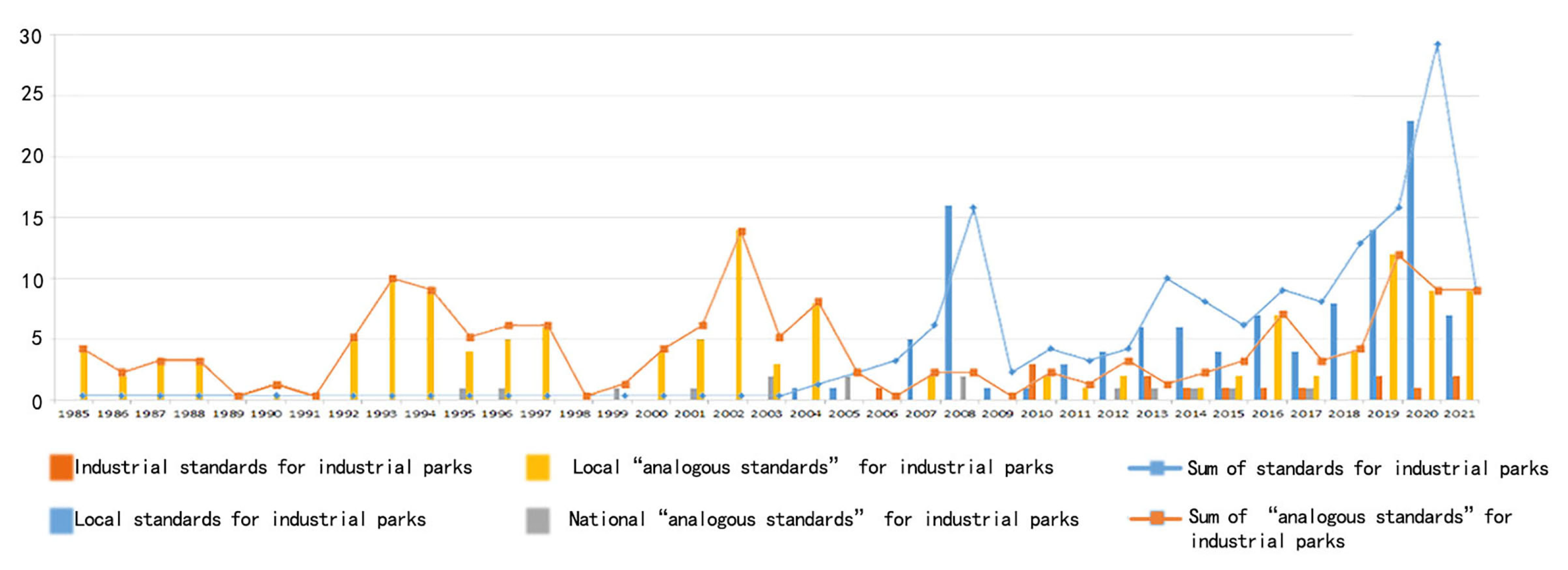
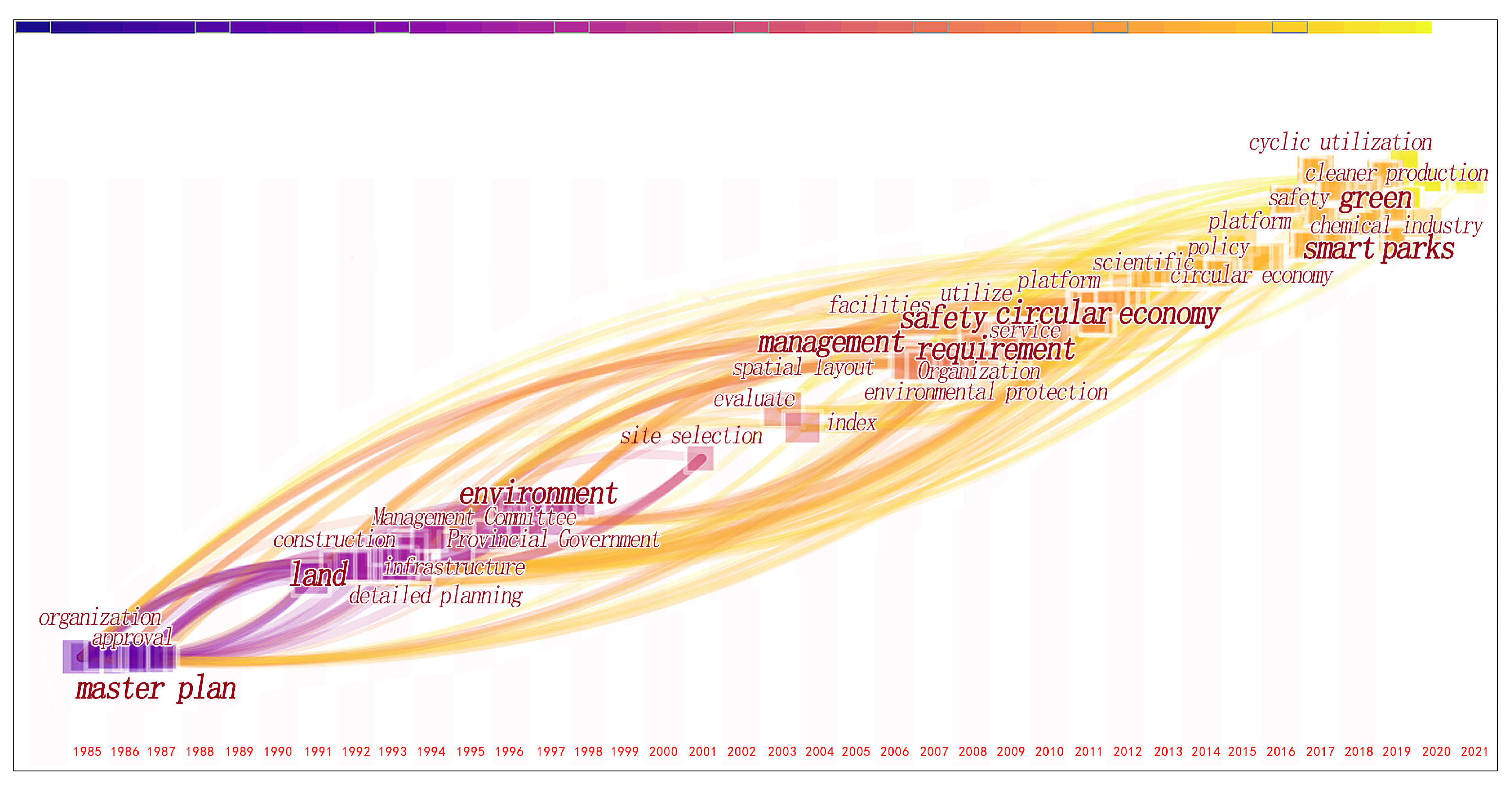

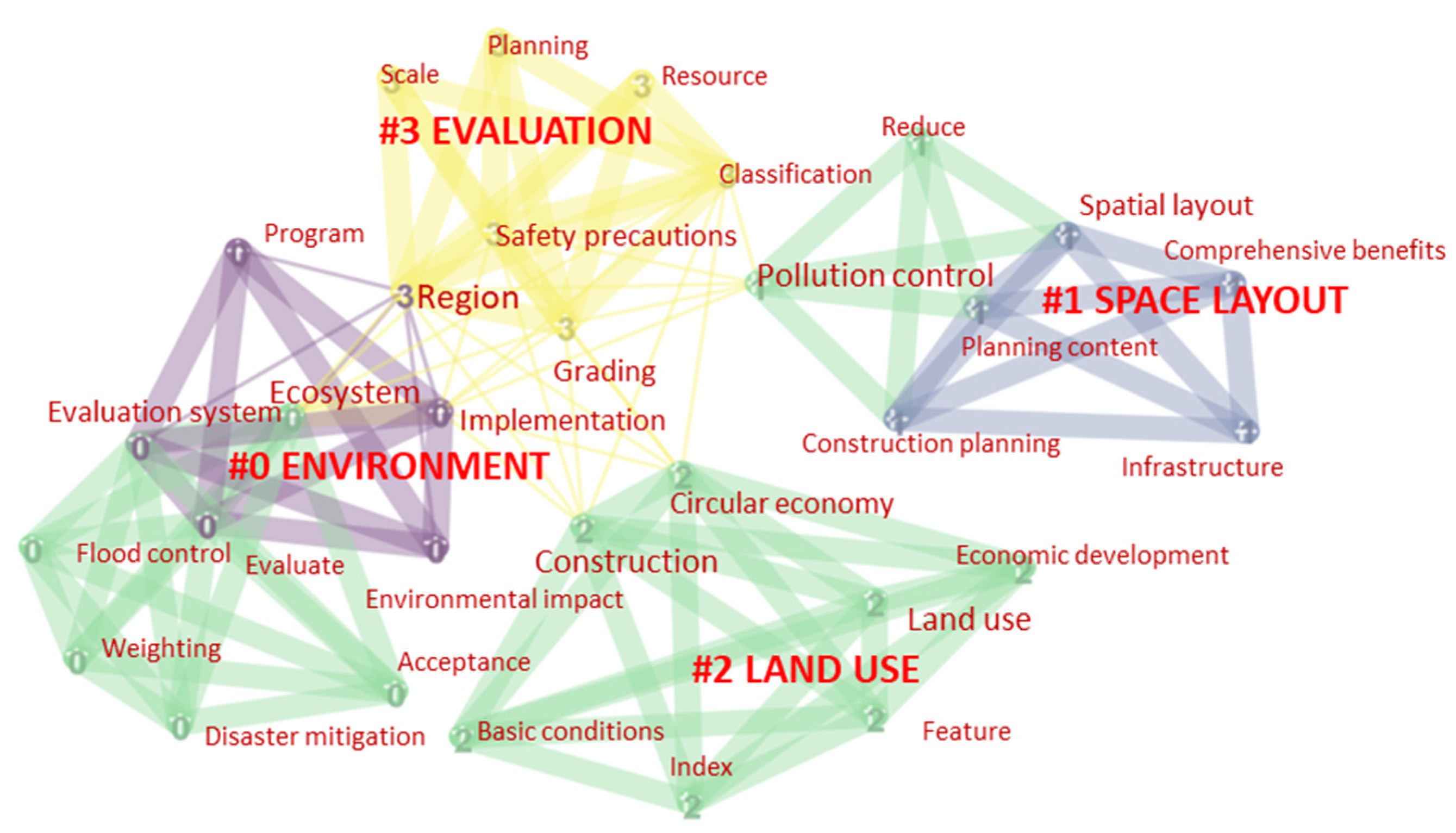
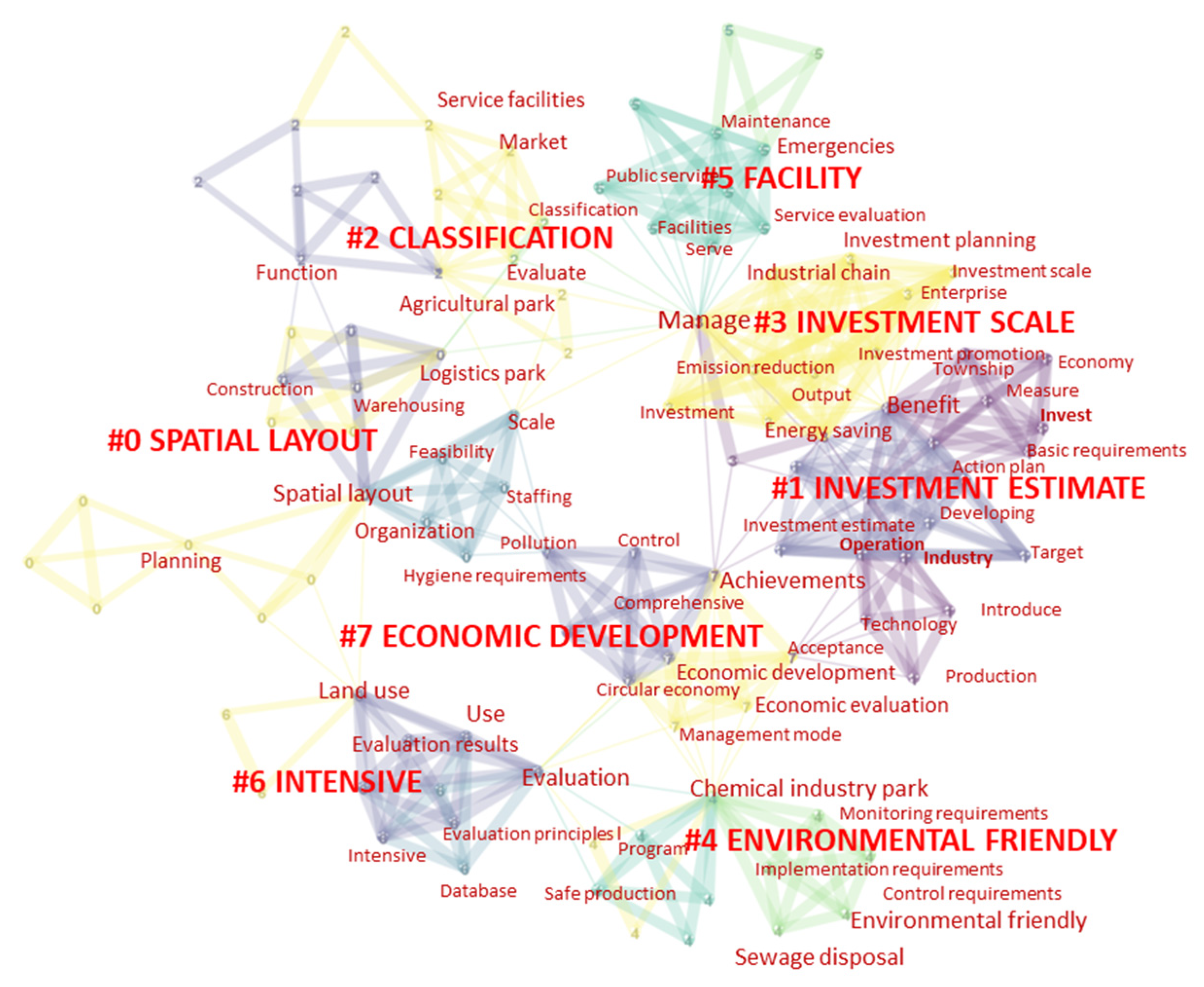

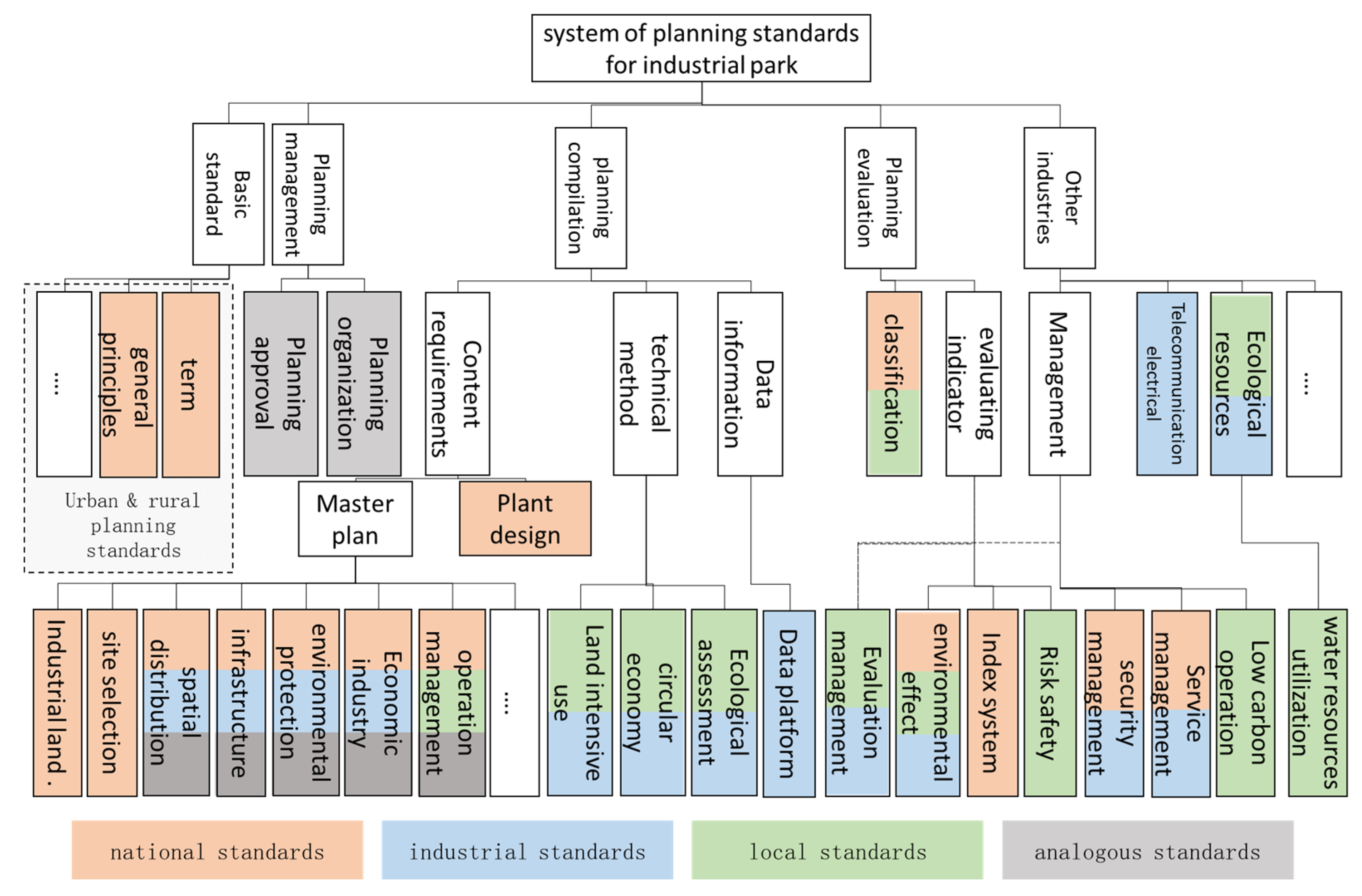


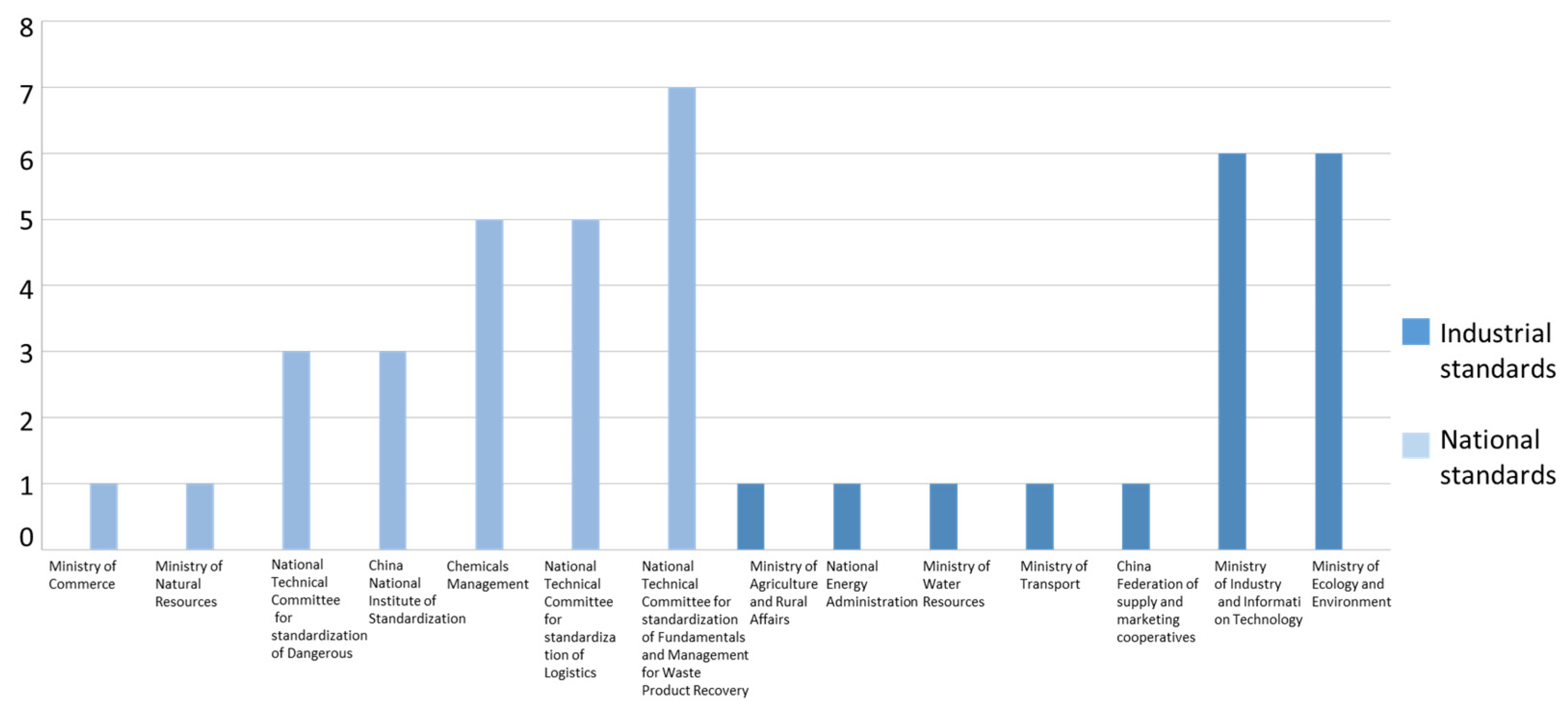
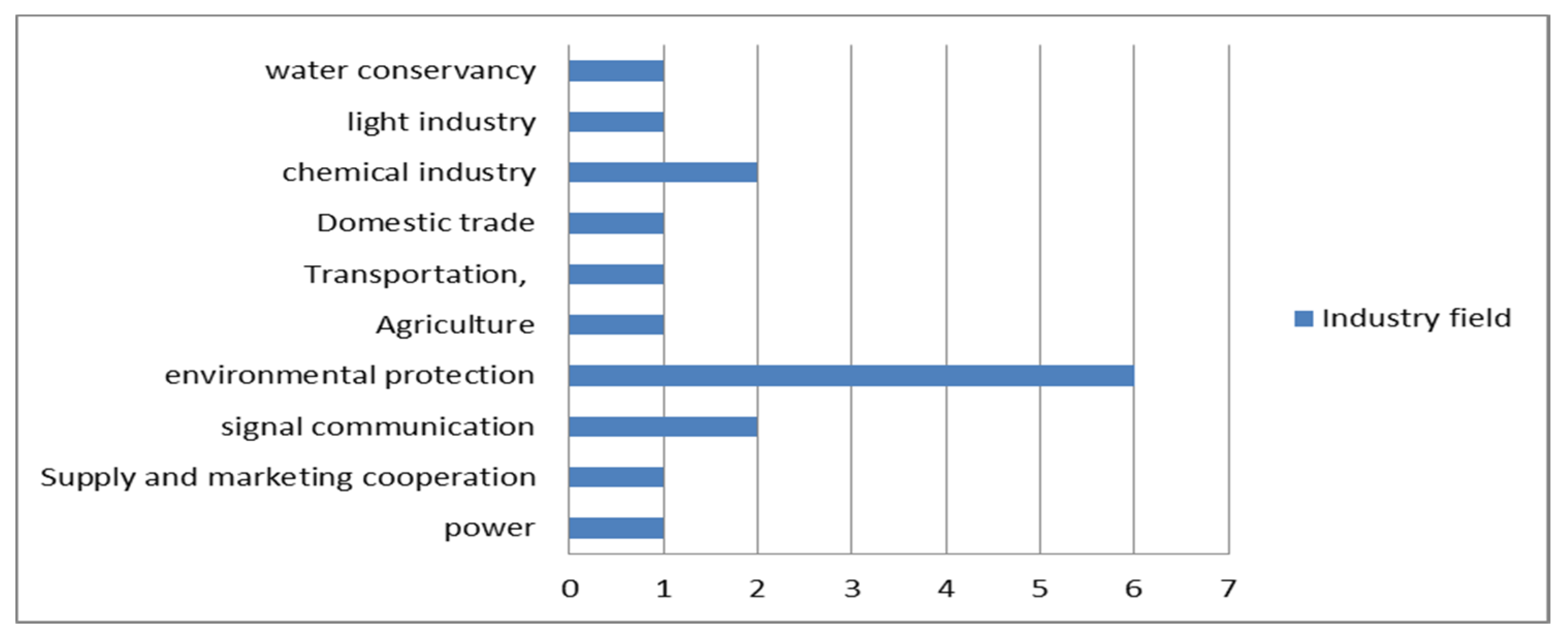
| Indicator Type | Indicator Breakdown | Number of Indicators (Green Chemical Park Evaluation Guidelines) | Number of Indicators (Comprehensive Eco-Industrial Park Standards) |
|---|---|---|---|
| Resource utilization | Land utilization | 5 | 1 |
| Energy utilization | 1 | 2 | |
| Water resources utilization | 3 | 4 | |
| Comprehensive utilization rate of industrial solid waste | × | 1 | |
| Environmental protection | Hazardous substance discharge and treatment | 5 | 2 |
| Setting elastic coefficients | × | 2 | |
| Wastewater discharge | × | 1 | |
| Solid waste disposal and utilization (including hazardous waste) | × | 3 | |
| Compliant environment quality | 3 | × | |
| Eco-friendly investment ratio | 1 | × | |
| Infrastructure | Water supply and wastewater treatment facilities | 2 | 1 |
| Waste treatment facilities | 1 | 1 | |
| Domestic waste treatment facilities | × | 1 | |
| Centralized heating facilities | 1 | × | |
| Public corridor facilities | 1 | × | |
| Park management | Environment management system and capability | 2 | 2 |
| Information platform building | 2 | 1 | |
| Green development system and capability | 4 | × | |
| Business management system and capability | × | 1 | |
| Establishment of a project access and exit mechanism | 1 | × | |
| Public engagement and employee care | 1 | 2 | |
| Economic industry | Economic development | 1 | 2 |
| Industry green development | 3 | × | |
| Clean production | 1 | × | |
| Construction of key projects | 1 | × |
| Indicator Type | Indicator Type | Green Chemical Park Evaluation Guidelines | Comprehensive Eco-Industrial Park Standards |
|---|---|---|---|
| Land yield rate | 100 million yuan/km2 | ≥30 | ≥9 |
| Energy yield rate | 10,000 yuan/tce | ≤cee | ≤cee |
| Industrial water reuse rate | % | ≥nd | ≥nd |
| Reclaimed water reuse rate | % | ≥ec | ≥ec |
| Industrial solid waste recycling rate | % | ≥li | ≥li |
Publisher’s Note: MDPI stays neutral with regard to jurisdictional claims in published maps and institutional affiliations. |
© 2022 by the authors. Licensee MDPI, Basel, Switzerland. This article is an open access article distributed under the terms and conditions of the Creative Commons Attribution (CC BY) license (https://creativecommons.org/licenses/by/4.0/).
Share and Cite
Chen, X.; Wang, X. From “Land-Oriented” to “Human-Oriented”: Research on Evolution Features of China’s Industrial Park Planning Standards. Sustainability 2022, 14, 5175. https://doi.org/10.3390/su14095175
Chen X, Wang X. From “Land-Oriented” to “Human-Oriented”: Research on Evolution Features of China’s Industrial Park Planning Standards. Sustainability. 2022; 14(9):5175. https://doi.org/10.3390/su14095175
Chicago/Turabian StyleChen, Xiao, and Xingping Wang. 2022. "From “Land-Oriented” to “Human-Oriented”: Research on Evolution Features of China’s Industrial Park Planning Standards" Sustainability 14, no. 9: 5175. https://doi.org/10.3390/su14095175
APA StyleChen, X., & Wang, X. (2022). From “Land-Oriented” to “Human-Oriented”: Research on Evolution Features of China’s Industrial Park Planning Standards. Sustainability, 14(9), 5175. https://doi.org/10.3390/su14095175





